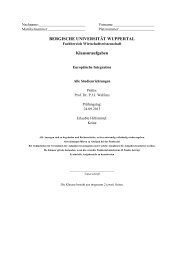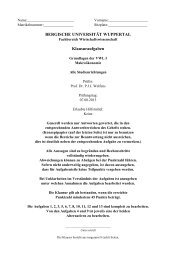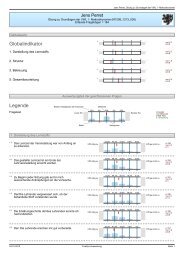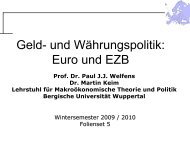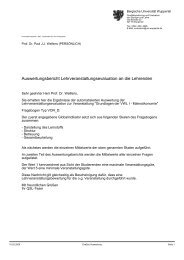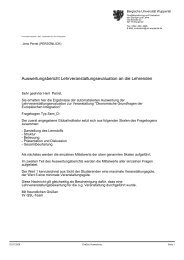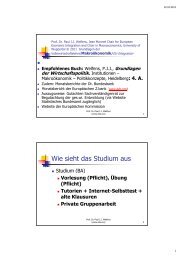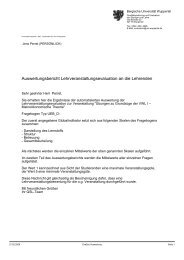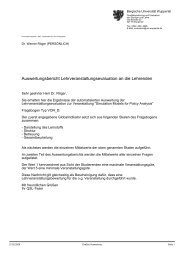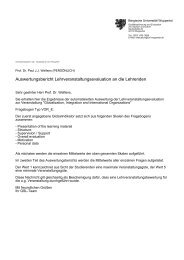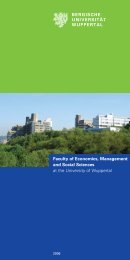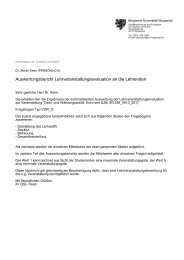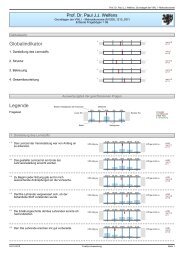UNIVERSITÄT POTSDAM - Prof. Dr. Paul JJ Welfens
UNIVERSITÄT POTSDAM - Prof. Dr. Paul JJ Welfens
UNIVERSITÄT POTSDAM - Prof. Dr. Paul JJ Welfens
You also want an ePaper? Increase the reach of your titles
YUMPU automatically turns print PDFs into web optimized ePapers that Google loves.
duction factors and the indicator variables for technical progress, as well as for the role<br />
of information and communication were considered, first of all the first step of Engle<br />
and Granger’s two-step procedure was applied, in which existing long-term relations<br />
were identified and estimated without specifying the short-term dynamics. However,<br />
the distribution of the estimators of the cointegrating vector provided by such a static<br />
regression is generally non-normal, and so inference cannot be drawn about the significance<br />
of the individual parameters by using the standard ‘t’ tests. For this reason the<br />
three-step procedure, proposed by Engle and Yoo (cf. ENGLE / YOO, 1991) was subsequently<br />
used to remedy this shortcoming. Their third step, added to the Engle-<br />
Granger two-step procedure, provided a correction to the parameter estimates of the<br />
first stage static regression which made them asymptotically equivalent to FIML and<br />
provided a set of standard errors which allows the valid calculation of standard ‘t’ tests.<br />
The superior long-term production function was then used to at least roughly assess the<br />
effects of the technical progress approximated by the indicator variables and of the<br />
need for information and communication, approximated by the number of telephone<br />
calls, as well as the impact of the usual production factors on economic growth from<br />
1961 until 1990.<br />
Tab 8: Estimation Results for the Augmented Production Function<br />
Variable First step of Engle/Granger Third step of Engle/Yoo<br />
unrestricted α + β =1<br />
unrestricted α + β =1<br />
Constant -3.1574 -2.7882 -3.4344 -3.1174<br />
(-4.8813) a) (-5.5155) (-12.8774) (-8.4231)<br />
k t<br />
0.4073 0.3634 0.4372 0.3448<br />
(4.9118) (5.3738) (11.2103) (5.9142)<br />
l t<br />
0.7460 0.6366 0.7893 0.6552<br />
(5.4446) -- (15.9455) --<br />
pat t−2<br />
0.1611 0.1833 0.1738 0.2315<br />
(1.6913) (1.9955) (6.2744) (3.4501)<br />
lex t<br />
0.0494 0.0631 0.0498 0.0833<br />
(1.5696) (2.2805) (4.4865) (3.5447)<br />
tc t<br />
0.1580 0.1803 0.1390 0.1795<br />
(2.7992) (3.5497) (5.7917) (4.2943)<br />
D80 -0.0168 -0.0165 -0.0169 -0.0161<br />
(-2.1905) (-2.1551) (-7.6818) (-2.9815)<br />
D81 -0.0202 -0.0223 -0.0202 -0.0239<br />
(-2.6738) (-3.0828) (-8.7826) (-4.3455)<br />
R 2 0.9977 0.9974 0.9976 0.9973<br />
37



